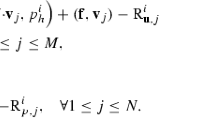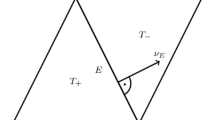Abstract
This paper introduces the first adaptive least-squares finite element method (LS-FEM) for the Stokes equations with optimal convergence rates based on the newest vertex bisection with lowest-order Raviart-Thomas and conforming \(P_1\) discrete spaces for the divergence least-squares formulation in 2D. Although the least-squares functional is a reliable and efficient error estimator, the novel refinement indicator stems from an alternative explicit residual-based a posteriori error control with exact solve. Particular interest is on the treatment of the data approximation error which requires a separate marking strategy. The paper proves linear convergence in terms of the levels and optimal convergence rates in terms of the number of unknowns relative to the notion of a non-linear approximation class. It extends and generalizes the approach of Carstensen and Park (SIAM J. Numer. Anal. 53:43–62 2015) from the Poisson model problem to the Stokes equations.


Similar content being viewed by others
References
Adler, J.H., Manteuffel, T.A., McCormick, S.F., Nolting, J.W., Ruge, J.W., Tang, L.: Efficiency based adaptive local refinement for first-order system least-squares formulations. SIAM J. Sci. Comput. 33(1), 1–24 (2011)
Aurada, M., Feischl, M., Kemetmüller, J., Page, M., Praetorius, D.: Each \(H^{1/2}\)-stable projection yields convergence and quasi-optimality of adaptive FEM with inhomogeneous Dirichlet data in \({\mathbb{R}}^d\). ESAIM Math. Model. Numer. Anal. 47(4), 1207–1235 (2013)
Bartels, S., Carstensen, C., Dolzmann, G.: Inhomogeneous Dirichlet conditions in a priori and a posteriori finite element error analysis. Numer. Math. 99(1), 1–24 (2004)
Becker, R., Mao, S.: Quasi-optimality of adaptive nonconforming finite element methods for the Stokes equations. SIAM J. Numer. Anal. 49(3), 970–991 (2011)
Berndt, M., Manteuffel, T.A., McCormick, S.F.: Local error estimates and adaptive refinement for first-order system least squares (FOSLS). Electron. Trans. Numer. Anal. 6, 35–43 (1997, (electronic) [Special issue on multilevel methods (Copper Mountain, CO, 1997)]
Binev, P., Dahmen, W., DeVore, R.: Adaptive finite element methods with convergence rates. Numer. Math. 97(2), 219–268 (2004)
Binev, P., DeVore, R.: Fast computation in adaptive tree approximation. Numer. Math. 97(2), 193–217 (2004)
Bochev, P.B., Gunzburger, M.D.: Least-squares finite element methods, Applied mathematical sciences, vol. 166. Springer, New York (2009)
Boffi, D., Brezzi, F., Fortin, M.: Mixed finite element methods and applications, Springer series in computational Mathematics, vol. 44. Springer, Heidelberg (2013)
Braess, D.: Finite elements, 3rd edn. Theory, fast solvers, and applications in elasticity theory, Translated from the German by Larry L. Schumaker. MR 2322235 (2008b:65142). Cambridge University Press, Cambridge (2007)
Brenner, S.C., Scott, L.R.: The mathematical theory of finite element methods, Texts in applied mathematics, vol. 15, 3rd edn. Springer, New York (2008)
Cai, Z., Lee, B., Wang, P.: Least-squares methods for incompressible Newtonian fluid flow: linear stationary problems. SIAM J. Numer. Anal. 42(2), 843–859 (2004, electronic)
Cai, Z., Tong, C., Vassilevski, P.S., Wang, C.: Mixed finite element methods for incompressible flow: stationary Stokes equations. Numer. Methods Partial Differ. Equ. 26(4), 957–978 (2010)
Cai, Z., Wang, Y.: A multigrid method for the pseudostress formulation of Stokes problems. SIAM J. Sci. Comput. 29(5), 2078–2095 (2007, electronic)
Carstensen, C., Gallistl, D., Schedensack, M.: \(L^2\) best-approximation of the elastic stress in the Arnold-Winther FEM. IMA J. Numer. Anal. (2015, published online). doi:10.1093/imanum/drv051
Carstensen, C.: An a posteriori error estimate for a first-kind integral equation. Math. Comput. 66(217), 139–155 (1997)
Carstensen, C., Feischl, M., Page, M., Praetorius, D.: Axioms of adaptivity. Comput. Math. Appl. 67(6), 1195–1253 (2014)
Carstensen, C., Gallistl, D., Schedensack, M.: Quasi-optimal adaptive pseudostress approximation of the stokes equations. SIAM J. Numer. Anal. 51(3), 1715–1734 (2013)
Carstensen, C., Kim, D., Park, E.-J.: A priori and a posteriori pseudostress-velocity mixed finite element error analysis for the Stokes problem. SIAM J. Numer. Anal. 49(6), 2501–2523 (2011)
Carstensen, C., Park, E.-J.: Convergence and optimality of adaptive least squares finite element methods. SIAM J. Numer. Anal. 53(1), 43–62 (2015)
Carstensen, C., Peterseim, D., Rabus, H.: Optimal adaptive nonconforming FEM for the Stokes problem. Numer. Math. 123(2), 291–308 (2013)
Carstensen, C., Rabus, H.: An optimal adaptive mixed finite element method. Math. Comput. 80(274), 649–667 (2011)
Cascon, J.M., Kreuzer, C., Nochetto, R.H., Siebert, K.G.: Quasi-optimal convergence rate for an adaptive finite element method. SIAM J. Numer. Anal. 46(5), 2524–2550 (2008)
Feischl, M., Page, M., Praetorius, D.: Convergence and quasi-optimality of adaptive FEM with inhomogeneous Dirichlet data. J. Comput. Appl. Math. 255, 481–501 (2014)
Jun, H., Jinchao, X.: Convergence and optimality of the adaptive nonconforming linear element method for the Stokes problem. J. Sci. Comput. 55(1), 125–148 (2013)
Scott, L.R., Zhang, S.: Finite element interpolation of nonsmooth functions satisfying boundary conditions. Math. Comput. 54(190), 483–493 (1990)
Stevenson, R.: Optimality of a standard adaptive finite element method. Found. Comput. Math. 7(2), 245–269 (2007)
Stevenson, R.: The completion of locally refined simplicial partitions created by bisection. Math. Comput. 77(261), 227–241 (2008, electronic)
Verfürth, R.: A posteriori error estimation techniques for finite element methods, Numerical mathematics and scientific computation. Oxford University Press, Oxford (2013)
Zhong, L., Chen, L., Shu, S., Wittum, G., Jinchao, X.: Convergence and optimality of adaptive edge finite element methods for time-harmonic Maxwell equations. Math. Comput. 81(278), 623–642 (2012)
Acknowledgments
This work was supported by Deutsche Forschungsgemeinschaft (DFG) SPP 1748.
Author information
Authors and Affiliations
Corresponding author
Appendix: Proofs of Lemma 4.5–4.7
Appendix: Proofs of Lemma 4.5–4.7
Proof
(Proof of Lemma 4.5) For g replaced by \(\widehat{I} g \in S^{1}(\widehat{\mathcal {E}}({\Gamma });{\mathbb {R}}^2)\), Lemma 2.1 guarantees the existence of some \(\widehat{z}\in S^{1}(\widehat{\mathcal {T}};{\mathbb {R}}^2)\) with
The discrete equation (11) with respect to \(\widehat{\mathcal {T}}\) with test functions \({\varvec{\tau }}_{\mathrm{LS}}= \widehat{{\varvec{\sigma }}}_{\mathrm{LS}}-{\varvec{\sigma }}_{\mathrm{LS}}\in {\varvec{\Sigma }}(\widehat{\mathcal {T}})\) and \(v_{\mathrm{LS}}= \widehat{u}_{\mathrm{LS}}-u_{\mathrm{LS}}-\widehat{z}\in S^{1}_0(\widehat{\mathcal {T}};{\mathbb {R}}^2)\) imply that
The discrete equation (11) with respect to \({\varvec{\tau }}_{\mathrm{LS}}= {\varvec{\tau }}_{\mathrm{PS}}\) and the triangulation \(\mathcal {T}\) and (21) result in
The combination of the preceding two displayed formulas proves
This plus some elementary algebra leads to
The remaining analysis in this proof concerns the split
The Eq. (21) imply that the Raviart-Thomas function
is divergence-free and so piecewise constant. The Helmholtz decomposition (14),
leads to some \(\widehat{\alpha }\in Z(\widehat{\mathcal {T}})\) and \(\widehat{\beta }\in X(\widehat{\mathcal {T}})\). The orthogonality and a piecewise integration by parts show
Recall that the Raviart-Thomas function \(\widehat{\varvec{\rho }}\) is continuous in its normal components and that \(\widehat{\varvec{\rho }}\nu _E\) is constant along \(E\in \widehat{\mathcal {E}}(\Omega )\). Since the jump \([\widehat{\alpha } ]_E\) of E has integral mean zero along E,
Hence, \(\widehat{\alpha }\equiv 0\) and the Helmholtz decomposition reduces to
for the divergence-free test function \({{\mathrm{Curl}}}\widehat{\beta } \in RT_0(\widehat{\mathcal {T}};\mathbb {R}^{2 \times 2})\). One term in (43) reads
The discrete equation (11) with respect to the triangulation \(\widehat{\mathcal {T}}\), \({\varvec{\tau }}_{\mathrm{LS}}=\widehat{{\varvec{\tau }}}_{\mathrm{PS}}-\widehat{{\varvec{\tau }}}_{\mathrm{PS}}^*\), and \(v_{\mathrm{LS}}\equiv 0\), and the combination with (21) plus elementary algebra with the \(L^2\)-projection \(\Pi \) onto \(P_0(\mathcal {T};{\mathbb {R}}^{2\times 2})\) show
The combination of (43)–(47) concludes the proof. \(\square \)
Proof
(Proof of Lemma 4.6) Let \(v \in S^{1}_0(\mathcal {T};{\mathbb {R}}^2)\) be the Scott-Zhang quasi-interpolation of \(\widehat{v}:= \widehat{u}_{\mathrm{LS}}-u_{\mathrm{LS}}-\widehat{z} \in S^{1}_0(\widehat{\mathcal {T}};{\mathbb {R}}^2)\). For every \(z\in \mathcal {N}\) in the construction of the quasi-interpolation [26, Section 2], choose \(E\in \mathcal {E}(\omega _z)\) such that \(E\in \mathcal {E}\cap \widehat{\mathcal {E}}\), whenever possible. This ensures that the error function \(\widehat{w}:= \widehat{v}-v \in S^{1}_0(\widehat{\mathcal {T}};{\mathbb {R}}^2)\) of the quasi-interpolation vanishes on any \(T\in \mathcal {T}\cap \widehat{\mathcal {T}}\). The first-order approximation property [26, equation (4.3)] and the stability property [26, Theorem3.1] read
for the enlarged triangle patch \(\Omega _T := \bigcup _{z \in \mathcal {N}(T)} \omega _z\) on the triangulation \(\mathcal {T}\) of Fig. 3.
Since \(v\in S^{1}_0(\mathcal {T};{\mathbb {R}}^2)\) is an admissible test function, (11) implies
This, the definition of \(\widehat{w}\), and a piecewise integration by parts result in
Given any \(T\in \mathcal {T}{\setminus }\widehat{\mathcal {T}}\), a Cauchy-Schwarz inequality plus (48) prove
Given any \(T\in \mathcal {T}{\setminus }\widehat{\mathcal {T}}\) with \(E\in \mathcal {E}(T)\), a combination of a Cauchy-Schwarz inequality, a trace inequality, and (48) result in
The combination of (49) with the last two preceding estimates and a finite overlap of the patches \(\Omega _T\) from Fig. 3 conclude the proof. \(\square \)
Proof
(Proof of Lemma 4.7) Let \(\beta \in S^{1}(\mathcal {T};{\mathbb {R}}^2)\) be the Scott-Zhang quasi-interpolation of \(\widehat{\beta }\in S^{1}(\widehat{\mathcal {T}};{\mathbb {R}}^2)\). For every \(z\in \mathcal {N}\) in the design of the quasi-interpolation [26, Section 2], choose \(E\in \mathcal {E}(\omega _z)\) such that \(E\in \mathcal {E}\cap \widehat{\mathcal {E}}\), whenever possible, so that the error function \(\widehat{\gamma } := \widehat{\beta } - \beta \in S^{1}(\widehat{\mathcal {T}};{\mathbb {R}}^2)\) of the quasi-interpolation vanishes on any \(T\in \mathcal {T}\cap \widehat{\mathcal {T}}\). The first-order approximation property [26, equation (4.3)] and the stability property [26, Theorem 3.1] read, with the enlarged triangle patch \(\Omega _T\) of Fig. 3, as
For \(x=(x_1,x_2)\in \bar{\Omega }\), define a modified quasi-interpolation \(\widetilde{\beta }\in S^{1}(\mathcal {T};{\mathbb {R}}^2)\) by
This guarantees that \( {{\mathrm{Curl}}}\widetilde{\beta } = {{\mathrm{Curl}}}\beta - c/2\, I_{2\times 2}\in {\varvec{\Sigma }}(\mathcal {T}) \) is an admissible and divergence-free test function. Therefore, the discrete equation (11) proves
This plus elementary algebra on the deviatoric part and a piecewise integration by parts imply
Given any \(T\in \mathcal {T}{\setminus }\widehat{\mathcal {T}}\), a Cauchy-Schwarz inequality plus (50) prove
Given any \(T\in \mathcal {T}{\setminus }\widehat{\mathcal {T}}\) with \(E\in \mathcal {E}(T)\), a combination of a Cauchy-Schwarz inequality, a trace inequality, and (50) imply
The combination of (51) with the last two preceding estimates and a finite overlap of the patches \(\Omega _T\) from Fig. 3 prove
The subsequent stability property can be found in [13, Lemma 3.4] in different notation
The stability of PS-FEM applied to \(\widehat{{\varvec{\tau }}}_{\mathrm{PS}}-\widehat{{\varvec{\tau }}}_{\mathrm{PS}}^*\) and \({\varvec{\tau }}_{\mathrm{PS}}\) yields
Since \(\widehat{\beta }\in X(\widehat{\mathcal {T}})\), \({{\mathrm{Curl}}}\widehat{\beta } \in \varvec{\Sigma } (\widehat{\mathcal {T}})\). Hence, the tr-dev-div lemma (15), Eq. (45), definition (44), a triangle inequality, and (53) imply
This and (52) conclude the proof. \(\square \)
Rights and permissions
About this article
Cite this article
Bringmann, P., Carstensen, C. An adaptive least-squares FEM for the Stokes equations with optimal convergence rates. Numer. Math. 135, 459–492 (2017). https://doi.org/10.1007/s00211-016-0806-1
Received:
Revised:
Published:
Issue Date:
DOI: https://doi.org/10.1007/s00211-016-0806-1





